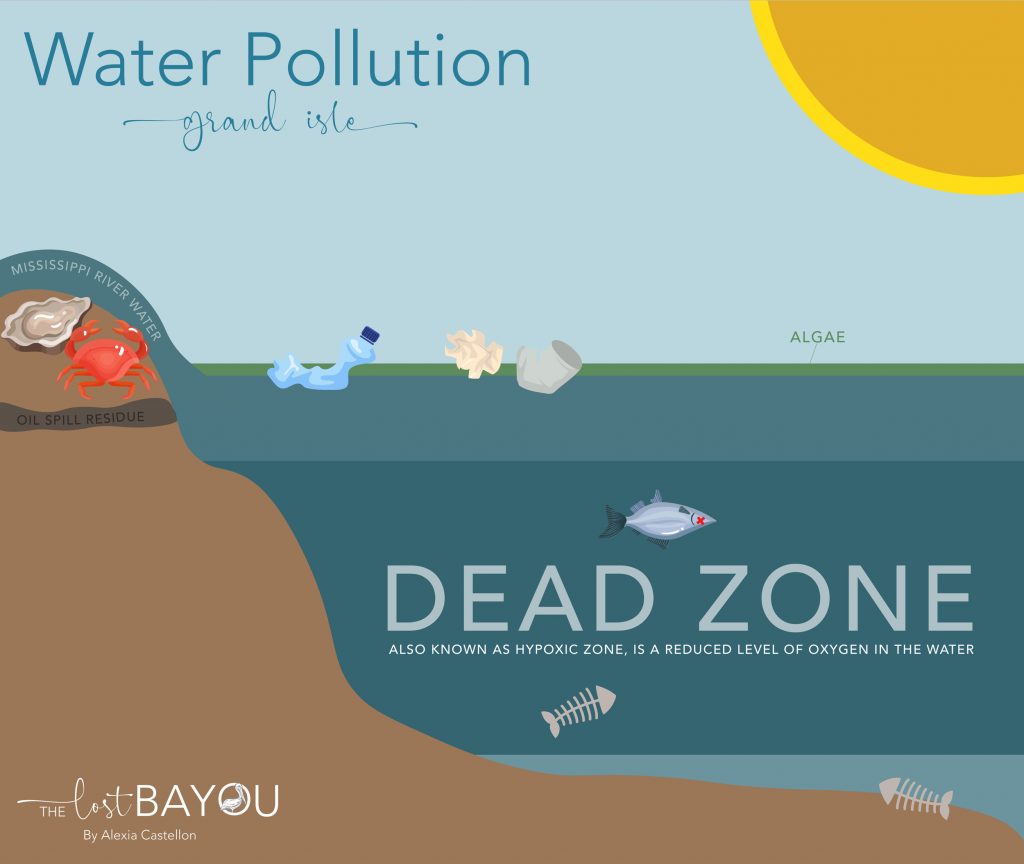By Brittany Chaisson, staff writer
Much of Louisiana’s coastal waters are polluted, but Grand Isle’s location at the mouth of the Mississippi River and its human inhabitants make its waters particularly susceptible to contamination. Experts say that agricultural runoff and marine debris are the leading cause of water pollution on Grand Isle’s coast.
“The thing that we think about at Grand Isle every summer is the hypoxic zone,” says biologist Dr. Gary Lafleur.
Dr. Andrew Willis, another biologist, says “It’s nothing that farmers are doing wrong, it’s just the nature of things.”
Dr. Willis explained that this fertilizer-contaminated water from the northern United States empties all the way down to the Gulf of Mexico where it collects along Grand Isle’s coast. As the water from the Mississippi flows into the Gulf, it floats above the denser salty seawater. This causes a separation where the freshwater and saline water meet, which prevents oxygenated surface water from oxygen-poor water on the bottom of the Gulf. These events create a hypoxic zone.
According to the Environmental Protection Agency, hypoxic zones are becoming more frequent as human inputs of these nutrients increase.
“When it comes to the water quality for fisheries and human health…the biggest source is from malfunctioning home sewage systems and camp systems,” says Andrew Barron, a member of the Barataria-Terrebonne National Estuary Program.
This malfunction can happen after bad storms when power outages cause water treatment systems to lose pressure. This loss of pressure prevents contaminants from entering through the cracks of pipes.
“The biggest issue is the high concentration of nutrients that lead to the formation of the area of hypoxia,” says barrier island researcher Willis. “This low water dissolved oxygen is bad for sea life”.
The excess nutrients in the water cause an overgrowth of algae on the water’s surface. This area of deoxygenated water is called a “dead zone”. The dead zone causes hypoxia in small sea creatures like shrimp in crabs, which quickly kills them. Larger marine life, like fish or shellfish, are not able to find a proper habitat and food, so their numbers deplete. This depletion in the fish population can negatively affect the local economy, which relies on the fishing industry.
A dead zone creates a phenomenon locals call a “Jubilee.” Lafleur explains that it is called a “Jubilee” because of the “drunkenness” caused by the upward movement of oxygen-poor waters, which forces fish and crustaceans from the bottom of the hypoxic zone ashore.
“Sometimes you can see crabs and speckled trout, almost acting as if they’re drunk,” says Lafleur. “They’re not dead yet, but they’re not swimming well.”
In this “drunken” state, it is much easier to fish without netting. Because hypoxia doesn’t pollute or poison the fish, they are still consumable.
The marine life of Grand Isle is also harmed by marine debris such as oil and human waste.
“We’re still feeling the effects of the BP oil spill, which was more than 10 years ago,” says Lafleur. “After the BP oil spill, it appeared that the oil just disappeared from view, it sank to the bottom offshore and it can stay in the sediments offshore”.
Lafleur says that every time a storm has come over the last ten years, sediment has been stirred up, and oil returns to the shoreline. When this happens, organisms that burrow in the sand along the coast get contaminated. This contamination spreads when sea life or birds consume the contaminated organisms.
A popular tourist destination, Grand Isle attracts thousands of visitors to its beaches each year Human waste such as plastic bags and trash can pollute the island’s water. Tourists and offshore oil rigs both to Grand Isle’s pollution.
“The physical material, the trash, the garbage is intimately connected to the water quality,” explains Barron. “All of the water around Grand Isle receives quite a bit of debris.”
When trash enters the Gulf it becomes marine debris. Land surveyors find that there is a constant supply of this debris which harms the sea life who consume it.
“Methods of industrial work create factors such as an agricultural runoff, oil spills, and marine debris, which all contribute to the harmful consequences on those who live and fish on the coast.”


